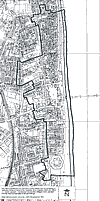Article 4(2) Direction
The architectural and historic importance of the Middle Street Deal Conservation Area has long been recognised. In 1968 it was the first Conservation Area in Kent to be designated and since that time the boundary has been extended three times. Its distinctive character is typified by the central axis of mainly Georgian terraced houses clustered around Middle Street, changing as you move towards Deal Castle, to grander Victorian villas.
If the special character of the town is to be preserved then it is important that buildings are repaired using traditional materials, Inappropriate repairs and alterations not only spoil the appearance of the area but can also devalue a property.
If you are the owner or tenant of a commercial property, or if you own or live in a flat you will already need planning permission for most external alterations. Similar controls now apply to dwelling houses and mean that extra care will need to be taken so that alterations do not unintentionally spoil the appearance of the street. The new controls are known as an Article 4(2) Direction and cover the whole of the Middle Street Conservation Area, the boundary of which is shown on the map.
Why Introduce the Changes?
The new Article 4(2) Direction will reinforce the Council's ability to protect the special character of the town. Additionally it will remove some of the anomalies, which currently exist between controls on single family dwelling houses, and all other types of property.
How are you affected?
The new Direction gives the District Council control over a variety of alterations to unlisted dwelling houses.

Map of area, click to enlarge
In summary, planning permission will now be required for changes to:
- windows, doors, roof materials and chimney stacks
- the painting of facades
- the construction of external porches
- the provision and removal of walls and fences and the provision of hard standings
These controls do not relate to the whole building, but only to those elevations which front a highway, waterway or public open space, and which therefore, affect the public face or faces of the building.
The best way of preserving the character of a building is to repair it using traditional materials. If you repair your house using identical materials then there will be no change to the external appearance and planning permission will not be required.
New planning controls
The new Direction will require the submission of a planning application for the following items of work, on a single unlisted dwelling house in the Deal Middle Street Conservation Area, where the works front a highway, waterway or open space:
- The enlargement, improvement or other alterations of the house. This includes changing windows and doors
- Any alteration to the roof. - this includes the provision of roof lights and dormer windows and the substitution of clay tiles or natural slates with concrete or other materials
- The erection or construction of a porch outside any external door
- The provision within the curtilage of a dwelling house or any new buildings or alteration of any existing ones
- The provision of a hard surface, for example to provide a car park in the front garden
- The erection, alteration or removal of a chimney on the house or on a building within its curtilage
- The erection, construction, maintenance, improvement or alteration of a gate, fence, wall or other means of enclosure
- The painting of the external masonry (or other walling material) of any part of the house (or building or enclosure within the curtilage of a house). This does not include the routine repainting or masonry or other walling material in the same colour
- The demolition in whole or part of any gate, fence, wall or other means of enclosure
- The installation, alteration or replacement of a satellite antenna on a dwelling house, or within the curtilage of a dwelling house
Planning applications
If you do need to apply for panning permission we will aim to ensure that your proposal does not detract from the special character of the conservation area and each application will be treated on its own merits. A decision normally takes between 5 to 8 weeks from the date of submission.
If your building is listed then you will require Listed Building Consent for both internal and external alterations and extensions. To check if your building is listed, please contact us.